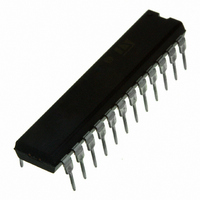L6228N STMicroelectronics, L6228N Datasheet - Page 14

L6228N
Manufacturer Part Number
L6228N
Description
IC DRIVER STEPPER MOTOR 24PWRDIP
Manufacturer
STMicroelectronics
Type
Driverr
Datasheet
1.L6228DTR.pdf
(26 pages)
Specifications of L6228N
Applications
Stepper Motor Driver
Number Of Outputs
1
Current - Output
1.4A
Voltage - Supply
8 V ~ 52 V
Operating Temperature
-25°C ~ 125°C
Mounting Type
Through Hole
Package / Case
24-DIP (0.300", 7.62mm)
Product
Stepper Motor Controllers / Drivers
Operating Supply Voltage
8 V to 52 V
Supply Current
1.4 A
Mounting Style
Through Hole
Motor Type
Stepper
No. Of Outputs
4
Output Current
3.55A
Output Voltage
52V
Supply Voltage Range
8V To 52V
Driver Case Style
DIP
No. Of Pins
24
Operating Temperature Range
-40°C To +150°C
Rohs Compliant
Yes
For Use With
497-6818 - EVAL BOARD FOR L6228Q
Lead Free Status / RoHS Status
Lead free / RoHS Compliant
Voltage - Load
-
Lead Free Status / Rohs Status
Lead free / RoHS Compliant
Other names
497-5350-5
L6228N
L6228N
Available stocks
Company
Part Number
Manufacturer
Quantity
Price
Company:
Part Number:
L6228N
Manufacturer:
STMicroelectronics
Quantity:
740
Part Number:
L6228N
Manufacturer:
ST
Quantity:
20 000
L6228
DECAY MODES
The CONTROL input is used to select the behavior of the bridge during the off time. When the CONTROL pin
is low, the Fast Decay mode is selected and both transistors in the bridge are switched off during the off time.
When the CONTROL pin is high, the Slow Decay mode is selected and only the low side transistor of the bridge
is switched off during the off time.
Figure 14 shows the operation of the bridge in the Fast Decay mode. At the start of the off time, both of the
power MOS are switched off and the current recirculates through the two opposite free wheeling diodes. The
current decays with a high di/dt since the voltage across the coil is essentially the power supply voltage. After
the dead time, the lower power MOS in parallel with the conducting diode is turned on in synchronous rectifica-
tion mode. In applications where the motor current is low it is possible that the current can decay completely to
zero during the off time. At this point if both of the power MOS were operating in the synchronous rectification
mode it would then be possible for the current to build in the opposite direction. To prevent this only the lower
power MOS is operated in synchronous rectification mode. This operation is called Quasi-Synchronous Recti-
fication Mode. When the monostable times out, the power MOS are turned on again after some delay set by the
dead time to prevent cross conduction.
Figure 15 shows the operation of the bridge in the Slow Decay mode. At the start of the off time, the lower power
MOS is switched off and the current recirculates around the upper half of the bridge. Since the voltage across
the coil is low, the current decays slowly. After the dead time the upper power MOS is operated in the synchro-
nous rectification mode. When the monostable times out, the lower power MOS is turned on again after some
delay set by the dead time to prevent cross conduction.
Figure 14. Fast Decay Mode Output Stage Configurations
Figure 15. Slow Decay Mode Output Stage Configurations
STEPPING SEQUENCE GENERATION
The phase sequence generator is a state machine that provides the phase and enable inputs for the two bridges
to drive a stepper motor in either full step or half step. Two full step modes are possible, the Normal Drive Mode
where both phases are energized each step and the Wave Drive Mode where only one phase is energized at a
14/26
A) ON TIME
A) ON TIME
D01IN1335
D01IN1336
B) 1 s DEAD TIME
B) 1 s DEAD TIME
C) QUASI-SYNCHRONOUS
C) SYNCHRONOUS
RECTIFICATION
RECTIFICATION
D) 1 s SLOW DECAY
D) 1 s DEAD TIME













